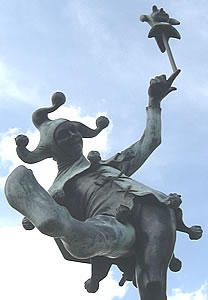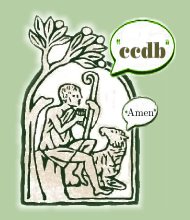Another Look at the Orans Issue
Arms wide extended? Or Hands together? Confusion and Canon law, clarified at Catholic Exchange.
I picked this one up from Happy Catholic
Some raise their arms and pray. Others close their hands together. The Celebrant sometimes does both. Unity shatters. What's going on?
Basically, there are times in the mass when the Priest that presides as celebrant prays for us and other times when he prays with us. When He prays for us, he is bound by litergical rubric, which specify how any liturgy or Sacrament is to be celebrated, to use the Orans position. This consists of praying with arms extended, palms up toward the sky. When he prays with us, he's to close his hands together.
Simple. Right? Well, enter the Our Father:
Eventually, the Pater became a prayer that was offered by the priest on behalf of the people, whose exterior participation in that prayer was, by the early 20th century, limited to a vicarious one via the server’s recitation of the closing line, Sed libera nos a malo (But deliver us from evil). A look at the pre-Conciliar rubrics in any sacramentary regarding the Pater is consistent in showing the priest’s hands extended, that is, in an orans position, as one would expect for prayers the priest offers on behalf of the congregation.
But in 1958, as part of Pope Pius XII’s liturgical reforms, permission was granted for, among other things, the congregation to join the priest in praying the Pater, provided that they could pray in Latin (AAS 50: 643; Eng. trans., Canon Law Digest V: 587). Thus, for the first time in many centuries, a congregational recitation of the Lord’s Prayer was possible. Lay recitation of the Pater was not mandated, and there is no evidence that this limited permission for congregational recitation of the Pater occasioned awareness that such permission, if it was widely acted upon, might necessitate a change in the rubrics. By then, it seems, the orans posture and the Lord’s Prayer were associated, not with the manner in which the prayer was being offered, but with the prayer itself. From there, it seems, the orans rubric for the priest during the Our Father simply passed unnoticed into the new rite of Mass.
With the introduction of the laity praying the Our Father with the priest, The prayer was no longer one that the priest prayed for the people. Hence, the priest should no longer use the orans position. However, the rubrics call for the orans position with this prayer. Thus, the presider continues.
Enter the confusion. Some people at mass simply follow the presider's lead. I've done that myself at the daily masses at St. Andrew's. After all I am, as jecil3 put it so eloquently, somewhat ignorant of Canon law. I also can't remember the last time I received instruction on the posture of prayer appropriate to the Our Father.
Dr. Edwards offers a solution:
But, if the above analysis is correct and the orans position has come to symbolize priestly prayer over the congregation instead of with it, then neither should the rubrics any longer call for the priest to extend his hands during the Our Father as if he is praying on behalf of the congregation. The rubrics should be changed to direct the priest to join his hands during the Our Father, as he does for other vocal prayers offered with the people. If Rome decides to do this, I think the orans issue might resolve itself quickly.
That makes sense. Change the rubric, the Priest changes. When the priest changes, those that have followed his lead in imitation will do the same. Any agenda that an ideological liturgist may have about enhancing the "priesthood of the laity" at the president's expense, or combating the so-called "clericalism" about the Priests role in the Mass, will die on the vine. The Church would be well served by this.





















<< Home